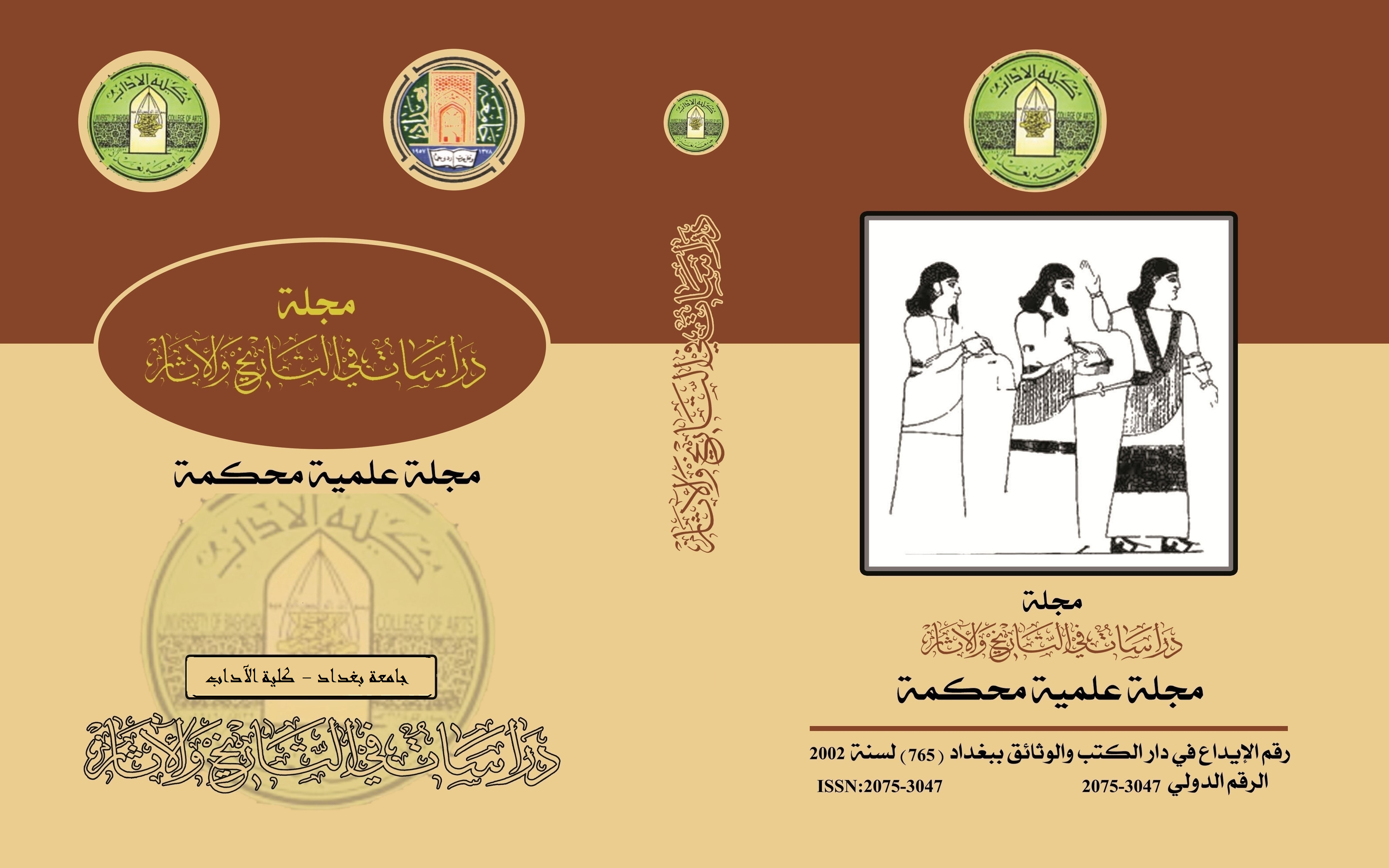دراسة أختام إسلامية من المتحف العراقي
الكلمات المفتاحية:
اختام إسلامية، عبارات قرآنية ودعائية، أحجار كريمة، ضمن علم Numismatiquesالملخص
تعتبر دراسة الأختام الإسلامية من الدراسات المهمة في الفنون الإسلامية، وهي تعد وثيقة مهمة تكشف لنا اسماء وألقاب وكنى وآيات وعبارات قرآنية وغير قرآنية، وقد عملت أغلبها من الأحجار الكريمة وأخيرًا اعتنت المتاحف العالمية بها كونها تمثل أنواع الخطوط العربية وغير العربية، وهذا دليل واضح بأهميتها فقد خصصت لها عروض خاصة بها وكتلوكات توضح الحجر الذي عملت منه وأحجامها وأوزانها وكل ما يتعلق بها.
المراجع
أبن الكازروني، ضمير الدين علي بن محمد، مختصر التاريخ، حققه: مصطفى جواد، مطبعة الحكومة، بغداد، 1970، الصابي، أبو الحسين هلال بن الحسن، الوزراء أو تحفة الأمراء في تاريخ الوزراء، تحقيق: عبد الستار أحمد فرج، دار أحياء الكتب العربية، 1958م، ص127.
ابن خلكان، أبو العباس شمس الدين أحمد بن علي بن أبي بكر، وفيات الأعيان وأنباء أبناء الزمان، حققه: إحسان عباس، دار صادر، بيروت، 1994م، ج1، الدروبي، محمد محمود أحمد، نقوش خواتم الخلفاء العباسيين، دراسة وتحقيق: حوليات الآداب والعلوم الاجتماعية، الحولية 34، الأردن، 2014م، ص16.
ابن منظور، أبو الفضل جمال الدين محمد بن مكرم، لسان العرب، دار صادر، بيروت، ط1، 1990م، مج12. وابن سيدة، أبو الحسن إسماعيل، المخصص، ط1، مطبعة بولاق، 1318ه، مجلد 5، ص96
السمعاني، الإمام ابي سعد عبد الكريم بن محمد ابن منصور التميمي، الأنساب، دار الجنان، بيروت، ط1، 1988م، ج5.
السيوطي، الحافظ جلال الدين عبد الرحمن بن أبي بكر، تاريخ الخلفاء، تحقيق: محمد محي الدين عبد الحميد، بغداد، 1986م.
الطبري، أبي جعفر محمد بن جرير، تاريخ الطبري تاريخ الرسل والملوك، تحقيق: محمد أبو الفضيل إبراهيم، ط5، دار المعارف، مصر، 1990م، ج5.
ثانيًا: المراجع العربية
الأبطحي، محمد صدر الموحد، الأحجار الكريمة وخواصها العجيبة، بيروت، 2012م. والشيخ، علي كاظم، الأختام الإسلامية ما بين اقتنائها وضياعها، مجلة السفير، أمانة مسجد الكوفة، السنة الثالثة، العدد14، 2012م، ص24-25.
إسماعيل، خالد سالم، الأحجار في المدونات العراقية القديمة، ندوة أحياء التراث العلمي العربي والإسلامي، جامعة بغداد، 1993م. والنقشبندي، إسامة ناصر، والحوري، حياة عبد علي، الأختام الإسلامية في المتحف العراقي، مديرية الآثار العامة، بغداد، 1974م، ص10-9.
الألوسي، عادل، الخط العربي نشأته وتطوره، القاهرة، 2008م.
باقر، طه، مقدمة في تاريخ الحضارات القديمة، ط2، بغداد، 1986م، ج1. الهاشمي، نسيبة محمد، الختم الإسلامية من ظهوره وتطوره، دراسة تحليلية لمجموعة من الأختام في المتحف العراقي، رسالة ماجستير غير منشورة، جامعة بغداد، 1991م، ص6.
برس، رشاد، الأحجار الكريمة بين العلم القديم والحديث، بيروت، ط1، 2004م.
الخزرجي، عمار، تحفة الأحجار، العراق، النجف، 2009م.
رمضان، عاطف منصور، موسوعة النقوش الأثارية على المسكوكات الإسلامية، القاهرة، 2018م، ج1.
زادة، محمد، تعلم اللغة الفارسية، بدون تاريخ.
شرف، وفاء السيد أحمد، دراسة ونشر الخاتم وقلادة بالأكاديمية الملكية بمدريد، المؤتمر الثالث عشر للاتحاد العام للآثاريين العرب، طرابلس، ليبيا، 2010م.
صالح، عبد العزيز حميد، ودفتر، ناهض عبد الرزاق، والعبيدي، صلاح حسين، الخط العربي، جامعة بغداد، 1990م.و حمودة، محمد عباس، تطور الكتبة الخطية العربية، ط1، القاهرة، 200م، ص145.
القيسي، ناهض عبد الرزاق، تاريخ الخط العربي، عمان، 2008م. و رمضان، عاطف منصور، موسوعة النقوش، ص66.
كيدا، أدورد، كتبوا على الطين، بغداد، 1962م.
مرتضى، موسى، وعلامة، معصومة، الموسوعة الشاملة للأحجار الكريمة، بيروت، مؤسسة الأعلمي، 2014م.
النقشبندي، إسامة ناصر، والحوري، حياة عبد علي، الأختام الإسلامية في المتحف العراقي، مديرية الآثار العامة، بغداد، 1974م.
ثالثًا: الرسائل والأطاريح
العماري، نعيمة علي جلاب، سيوف أسد الله الدمشقي وأسد الله الأصفهاني المحفوظة في متحف الكفيف (نماذج مختارة)، رسالة ماجستير غير منشورة، جامعة بغداد، كلية الآداب، 2021م.
رابعًا: المجموعات الخاصة
مجموعة خاصة بالسيد محمد سيد كاظم، كربلاء، تاريخ 5/11/2014م.
خامسًا: المصادر الأجنبية
J.M. Rogers, the arts of Islam, master pieces from, the Khalil collection, London, 2007.
Mitchiner, Michael, riental coins their values, the world of Islam, London, 2000.
Porter, Venetia, Arabic and persian seals and Amulets in the British Museum, London, 2011.
التنزيلات
منشور
إصدار
القسم
الرخصة

هذا العمل مرخص بموجب Creative Commons Attribution 4.0 International License.
:حقوق الطبع والنشر والترخيص
بالنسبة لجميع البحوث المنشورة في مجلة دراسات في التاريخ والآثار، يحتفظ الباحثون بحقوق النشر. يتم ترخيص البحوث بموجب ترخيص Creative Commons CC BY 4.0 المفتوح ، مما يعني أنه يجوز لأي شخص تنزيل البحث وقراءته مجانًا. بالإضافة إلى ذلك ، يجوز إعادة استخدام البحث واقتباسه شريطة أن يتم الاستشهاد المصدر المنشور الأصلي. تتيح هذه الشروط الاستخدام الأقصى لعمل الباحث وعرضه.
:إعادة إنتاج البحوث المنشورة من الناشرين الآخرين
من الضروري للغاية أن يحصل الباحثون على إذن لإعادة إنتاج أي بحث منشورة (أشكال أو مخططات أو جداول أو أي مقتطفات من نص) لا يدخل في نطاق الملكية العامة أو لا يملكون حقوق نشرها. يجب أن يطلب الباحثون إذنًا من مؤلف حقوق النشر (عادة ما يكون الناشر).
يطلب الإذن في الحالات التالية:
بحوثك الخاصة المنشورة من قِبل ناشرين آخرين ولم تحتفظ بحقوق النشر الخاصة بها.
مقتطفات كبيرة من بحوث أي شخص أو سلسلة من البحوث المنشورة.
استخدم الجداول والرسوم البيانية والمخططات والمخططات والأعمال الفنية إذا لم يتم التعديل عليها.
الصور الفوتوغرافية التي لا تملك حقوق لنشرها.
لا يطلب الإذن في الحالات التالية:
إعادة بناء الجدول الخاص بك مع البيانات المنشورة بالفعل في مكان آخر. يرجى ملاحظة أنه في هذه الحالة يجب عليك ذكر مصدر البيانات في شكل "بيانات من ..." أو "مقتبس من ...".
تعتبر عروض الأسعار القصيرة معقولة الاستخدام العادل ، وبالتالي لا تتطلب إذنًا.
الرسوم البيانية ، الرسوم البيانية ، المخططات ، الأعمال الفنية التي أعاد الباحث رسمها بالكامل والتي تم تغييرها بشكل ملحوظ إلى درجة لا تتطلب الاعتراف.
الحصول على إذن
لتجنب التأخير غير الضروري في عملية النشر ، يجب أن تبدأ في الحصول على أذونات في أقرب وقت ممكن. لا يمكن لمجلة الآداب نشر بحث مقتبس من منشورات أخرى دون إذن.
قد يمنحك مالك حقوق الطبع والنشر تعليمات بشأن شكل الإقرار الواجب اتباعه لتوثيق عمله ؛ بخلاف ذلك ، اتبع النمط: "مستنسخ بإذن من [المؤلف] ، [كتاب / المجلة] ؛ نشره [الناشر] ، [السنة]." في نهاية شرح الجدول ، الشكل أو المخطط.



















